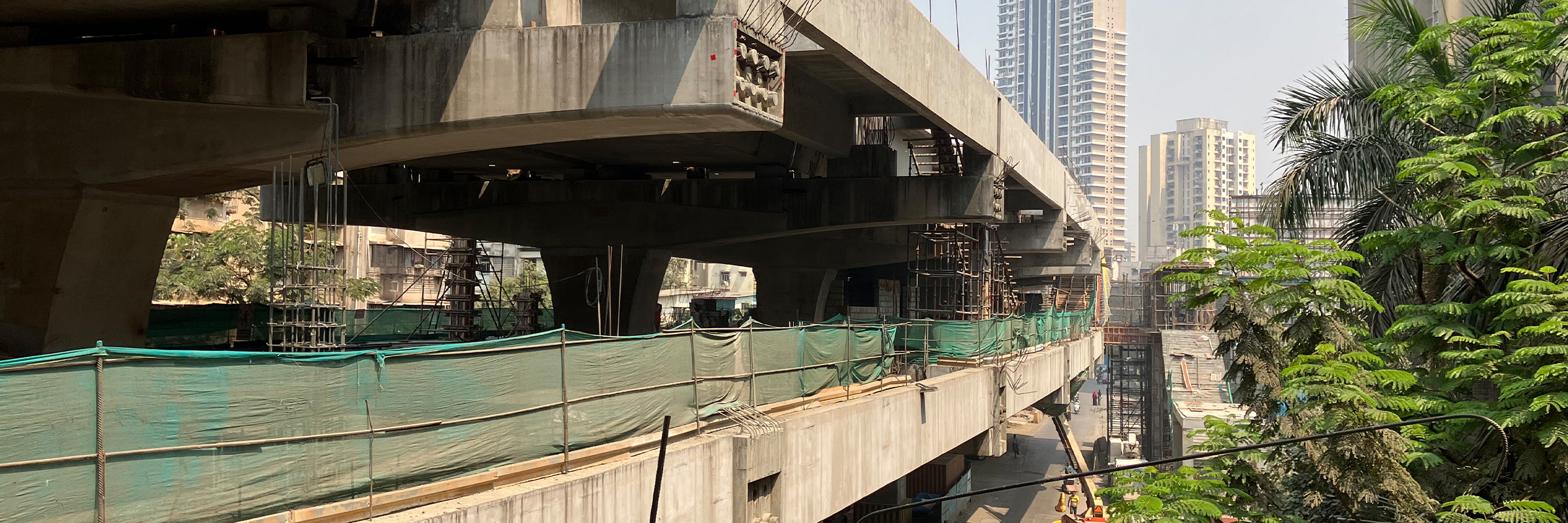
Navigating a Dense Urban Landscape
Constructing an elevated metro line in a densely populated city like Mumbai, where land is scarce, presents a unique set of challenges. The Pink Line must navigate through a complex web of existing infrastructure, including flyovers, expressways, railway corridors, and interchanges with other metro lines. The project requires careful integration of the metro line with the numerous intersections and junctions, which include four critical crossings:
Western Railway Line – The viaduct will span approximately 34 metres across the railway line, with supporting piers elevated to approximately 20 metres above ground level.
Central Railway Line – The crossing will feature viaduct piers with a span of approximately 88 metres and a height of 17 metres above ground level.
Crossing the Western Express Highway – This three-level crossing involves a road flyover at ground level, a viaduct for Metro Line 7 above the flyover, and Metro Line 6 positioned above all at an approximate height of 24 metres.
LBS Marg Crossing – Another three-level crossing, featuring a road flyover at ground level, a viaduct for Metro Line 4 above the flyover, and our Metro Line 6 viaduct crossing at approximately 31 metres above ground level.
These engineering feats, while necessary, add significant complexity to the project.
Context-Driven Solutions for a Diverse City
In response to the unique challenges posed by Mumbai’s urban landscape, the design of Line 6 has been meticulously tailored to suit its context. Each station reflects the cultural, environmental, or urban significance of its location. For instance, Mahakali Caves Station draws inspiration from the nearby Buddhist monastery caves, integrating the essence of these ancient landmarks into the station’s art and architectural design.
SMEC’s role in this project involves detailed architectural planning and design for all 13 stations, adapting the designs to minimise space usage while meeting stringent structural and alignment requirements. Commenced in 2018, continuous optimisation has been key to maintaining aesthetic quality and construction efficiency.



Engineering Excellence and Sustainability
Our specialists are also conducting rigorous proof-checking of the structural integrity of the elevated viaduct, ensuring rail levels reach as high as 25 metres above ground. This requires rigorous verification to balance structural demands with aesthetic considerations.
One particularly innovative aspect is the unique interchange scheme, where limited space requires passenger transfers between different metro phases via a hanging structure between two stations. This efficient use of space underscores the project’s smart engineering.
Sustainability is a central focus of this project, with plans to install solar panels on station rooftops, harnessing renewable energy. The project is pursuing IGBC Green Mass Rapid Transit System certification, which integrates green concepts into design and construction to minimise environmental impact. The station facade system features an external skin of louvred panels, enhancing cross-ventilation and reducing HVAC energy loads while being robust enough to handle Mumbai’s heavy rainfall without compromising natural light and airflow.
To optimise space utilisation, critical infrastructure such as sump tanks for domestic and fire use have been constructed below the roads, and the DG room is strategically positioned on the median. Additionally, several steel spans are proposed for the viaduct to accommodate larger spans at obligatory crossings. Notably, the 92-metre underslung truss span is the largest, and a 500-metre stretch of the elevated road and metro is ingeniously stacked one above the other to create a seamless integration of vehicular and metro transportation.
Looking Ahead
Currently under construction, MML6 is expected to be completed by 2025. This project adds to the extensive rail portfolio that SMEC has been developing in India and underscores our commitment to sustainable and impactful infrastructure development in the region. As MML6 continues to take shape, it promises to be a transformative addition to Mumbai’s transportation network, solving long-standing traffic issues and delivering a more connected future for the city.




